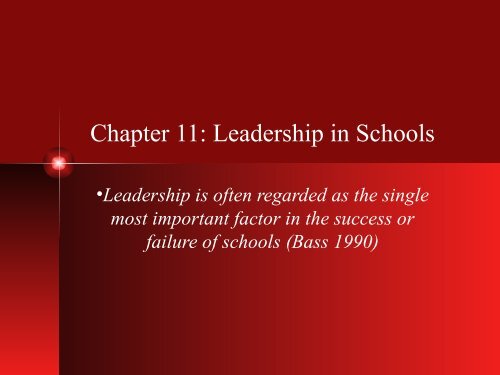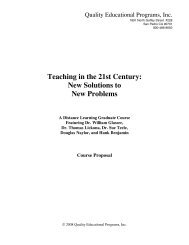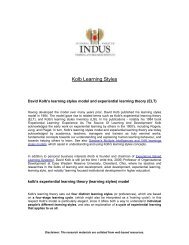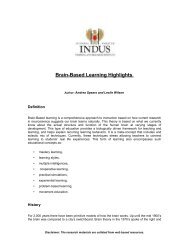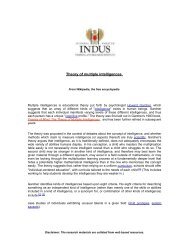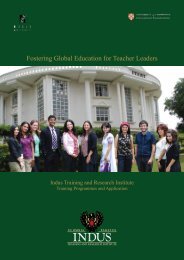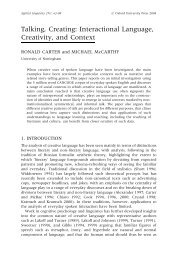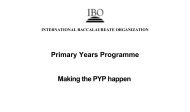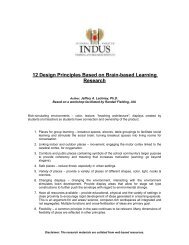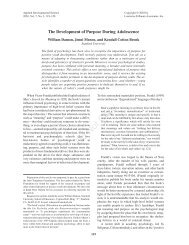Leadership in Schools - ITARI
Leadership in Schools - ITARI
Leadership in Schools - ITARI
- No tags were found...
Create successful ePaper yourself
Turn your PDF publications into a flip-book with our unique Google optimized e-Paper software.
Chapter 11: <strong>Leadership</strong> <strong>in</strong> <strong>Schools</strong>•<strong>Leadership</strong> is often regarded as the s<strong>in</strong>glemost important factor <strong>in</strong> the success orfailure of schools (Bass 1990)
<strong>Leadership</strong> Def<strong>in</strong>ed• Bennis (1989): like beauty, (or pornography), leadership ishard to def<strong>in</strong>e, but you know it when you see it• Chemers (1997:1): “…a process of social <strong>in</strong>fluence <strong>in</strong>which one person is able to enlist the aid and suppoer ofothers <strong>in</strong> the accomplishment of a common task”• Most def<strong>in</strong>itions agree that leadership <strong>in</strong>volves a social<strong>in</strong>fluence process; beyond that, scholars dispute whatleadership is
Controversy #1: Individuals or Roles and Processes?• Yukl (1998): all groups have a specialized leadership role withfunctions and responsibilities that can’t be shared without cost to theeffectiveness of the group• Individual with most <strong>in</strong>fluence is the leader; everybody else follows• Alternative view: leadership is a social process, shared among groupmembers• Ogawa & Bossert (1995): leadership is a quality of school organizations,flow<strong>in</strong>g through social networks and roles• Smylie & Hart (1999): leadership as an organizational property of schools• Spillane, Halverson & Diamond (2003): leadership distributed acrossleaders and followers, accord<strong>in</strong>g to situations• Katz & Kahn (1978): 3 major components of leadership:• 1. the attribute of an office or position• 2. characteristic of a person• 3. category of actual behavior
Controversy #2: Influence• Disagreement over how to def<strong>in</strong>e <strong>in</strong>fluence behaviors• By k<strong>in</strong>d? By outcome?• Some theorists only consider strategies that produce will<strong>in</strong>gcommitments by followers, and exclude neutral or reluctantresponses• Some theorists restrict def<strong>in</strong>ition of <strong>in</strong>fluence processes to taskgoals and group ma<strong>in</strong>tenance, and exclude <strong>in</strong>fluence attempts withother motives or beneficiaries• Traditional def<strong>in</strong>itions emphasize rational processes: leaders<strong>in</strong>fluence followers to believe it is <strong>in</strong> their best <strong>in</strong>terests tocooperate• Transformational and charismatic leaders: key on importance ofemotions—conv<strong>in</strong>ce followers to subord<strong>in</strong>ate self-<strong>in</strong>terest to largercause
Controversy #3: Leader or adm<strong>in</strong>istrator?• Adm<strong>in</strong>istrator: emphasizes stability and efficiency• Plan and budget, organize and staff, and control and solve problems• Leader: emphasizes adaptive change, consensus build<strong>in</strong>g• Establish direction, align people, motivate and <strong>in</strong>spire• Both terms refer to <strong>in</strong>dividuals who occupy positions <strong>in</strong> which they areexpected to exert leadership for subord<strong>in</strong>ates or followers<strong>Leadership</strong> def<strong>in</strong>ed broadly: a social process <strong>in</strong> which a member ormembers of a group <strong>in</strong>fluence the <strong>in</strong>terpretation of events, choice ofgoals/outcomes, organization of work activities, motivation, abilities,power relations, and shared orientations.• As a social <strong>in</strong>fluence process and a specialized role, leadership iscomprised of both rational and emotional elements
Life as an Adm<strong>in</strong>istrator• Structured observation studies reveal similarcharacteristics of adm<strong>in</strong>istrative jobs across countries andorganizational sett<strong>in</strong>gs:• School adm<strong>in</strong>istrators work long hours at a physically exhaust<strong>in</strong>gpace• School leaders rely on verbal media, and spend much time walk<strong>in</strong>gthrough the build<strong>in</strong>g and talk<strong>in</strong>g to <strong>in</strong>dividuals and groups• Adm<strong>in</strong>istration requires the ability to change gears and tasksfrequently• Span of concentration for school adm<strong>in</strong>istrators is short—the job isfragmented and discont<strong>in</strong>uity is prevalent• How does this leave room for leadership? Look totheoretical approaches to leadership for answer
Are leaders born or made?• Trait approach to leadership: key factors <strong>in</strong> determ<strong>in</strong><strong>in</strong>g leadership are<strong>in</strong>herited• Aristotle thought <strong>in</strong>dividuals were born with the qualities that wouldmake them good leaders• Bass (1990) chronicles historical approaches to leadership qualities <strong>in</strong>the US• Early 20 th Century: ;eaders regarded as superior <strong>in</strong>dividuals whobenefitted from <strong>in</strong>heritance or fortunate social circumstances to stand outamong peers• Researchers attempted to isolate these traits, such as physicalcharacteristics, personality factors, needs , values, energy and activitylevels, task and <strong>in</strong>terpersonal competence, <strong>in</strong>telligence, and charisma• This type of study dom<strong>in</strong>ated research until the 1950’s
Repudiation of the pure trait approach• Stogdill (1948) reviews 124 trait studies of leadership• Personal factors associated with leadership fell <strong>in</strong>to 5 generalcategories• Capacity: <strong>in</strong>telligence, alertness, verbal facility, orig<strong>in</strong>ality, judgment• Achievement: scholarship, knowledge, athletic accomplishments• Responsibility: dependability, <strong>in</strong>itiative, persistence, aggressiveness, selfconfidence,drive• Participation: activity, sociability, cooperation, adaptability, humor• Status: socioeconomic position, popularity• Stogdill’s meta-analysis casts dim view on pure trait research: impactof traits varies widely from situation to situation, so a person doesn’tbecome a leader based on the possession of traits alone• Stogdill adds sixth component: situational factors, such as followersand goals
Modern trait approaches to leadership• Shift <strong>in</strong> approach, from compar<strong>in</strong>g leaders to non-leaders to compar<strong>in</strong>g effective leadersto <strong>in</strong>effective ones• Trait studies now look at traits and leadership effectiveness <strong>in</strong> specific organizationaltypes and sett<strong>in</strong>gs• Stogdill, part II: <strong>in</strong> 1970, he reviewed 163 new trait studies• New meta-analysis found that leaders are characterized by the follow<strong>in</strong>g traits:• Drive for responsibility, task completion• Persistent pursuit of goals• Orig<strong>in</strong>ality <strong>in</strong> problem-solv<strong>in</strong>g• Initiative <strong>in</strong> social situations• Self-confidence, sense of personal identity• Will<strong>in</strong>gness to accept consequences of decision and action• Read<strong>in</strong>ess to absorb stress and tolerate frustration and delay• Ability to <strong>in</strong>fluence behavior of others• Capacity to structure <strong>in</strong>teractions for a purpose• Immegard (1988): traits of <strong>in</strong>telligence, dom<strong>in</strong>ance, self-confidence, and high energy arecommon to leaders• Bottom l<strong>in</strong>e: both traits and situations are important <strong>in</strong>fluences on whether a leader willbe effective
Personality, motivation, and skills• Trait and skill variables associated with effective leadership can bebroken <strong>in</strong>to three groups• Personality• Motivation• SkillsPersonality: relatively stable dispositions to behave <strong>in</strong> a particular way(Yukl, 2002)• Long list associated with effective leadership• 4 <strong>in</strong> particular worth not<strong>in</strong>g:• Self-confident leaders: more likely to set high goals and persist• Stress-tolerant leaders: make good decisions, stay calm, provide decisivedirections under stress• Emotionally mature leaders: have accurate awareness of strengths andweaknesses, are oriented toward self-improvement• Leaders with <strong>in</strong>tegrity: behaviors are consistent with stated values—theseleaders are seen as honest, ethical, responsible, and trustworthy
Motivational traits• Motivation: set of energetic forces from both with<strong>in</strong> and beyond an<strong>in</strong>dividual to <strong>in</strong>itiate work-related behavior and determ<strong>in</strong>e its form,direction, <strong>in</strong>tensity, and duration• Four motivational traits key for effective leaders:• Task and <strong>in</strong>terpersonal needs: effective leaders have drive for the task andconcern for people• Power needs: effective leaders seek positions of authority and arecomfortable exercis<strong>in</strong>g <strong>in</strong>fluence over others• Achievement orientation: effective leaders have a desire to excel, a driveto succeed, will<strong>in</strong>gness to assume responsibility• High expectations for success: effective leaders believe they can do thejob and will receive valued outcomes for their efforts• Physical traits, such as energy and activity, allow <strong>in</strong>dividuals to showtheir competence through active engagement
Skills• Too many skills to list, but some models group sets of skills that makefor effective leadership• Problem-solv<strong>in</strong>g skills, social judgment skills, & knowledge(Mumford et al, 2000)• Yukl (2002) and Northouse (2004): three important categories of skillsfor effective leadership• Technical: specialized knowledge about a specific type of work, activity,procedure, or technique• Interpersonal: understand<strong>in</strong>g of feel<strong>in</strong>gs and attitudes of others, know<strong>in</strong>ghow to work with people <strong>in</strong> <strong>in</strong>dividual and cooperative work relationships• Conceptual or cognitive: ability to conceptualize, th<strong>in</strong>k logically, reasonanalytically, deductively and <strong>in</strong>ductively• Effective leaders need all three, but priority depends upon level ofadm<strong>in</strong>istration
Situational approach to leadership• Response to trait approach: researchers identify sett<strong>in</strong>g characteristicsthat <strong>in</strong>fluence leader’s success• Possible situational determ<strong>in</strong>ants of leadership:• Structural properties of organization—size, hierarchy, formalization,technology• Role characteristics—type and difficulty of task, rules, content,performance expectations, power• Subord<strong>in</strong>ate characteristics—education, age, knowledge, experience,tolerance for ambiguity, responsibility, power• Internal environment—climate, culture, openness, participation levels,group atmosphere, values, norms• External environment—complexity, stability, uncerta<strong>in</strong>ty, resourcedependency, <strong>in</strong>stitutionalization• Situational approach and trait approach come <strong>in</strong>to balance: situationalfactors and personal factors have strong reciprocal associations
Major f<strong>in</strong>d<strong>in</strong>gs of OSU studies• Four major f<strong>in</strong>d<strong>in</strong>gs of LBDQ studies (Halp<strong>in</strong>, 1966)• Initiat<strong>in</strong>g structure and consideration are fundamental dimensionsof leader behavior• Effective leaders exhibit frequent behaviors on both dimensions• Superiors and subord<strong>in</strong>ates attribute success to behaviors <strong>in</strong>opposite dimensions: superiors tend to credit <strong>in</strong>itiat<strong>in</strong>g structurebehaviors; subord<strong>in</strong>ates tend to credit consideration behaviors• Th<strong>in</strong> relationship between leaders’ expressed beliefs on how theyshould behave, and subord<strong>in</strong>ates’ descriptions of how leaders dobehave
Recent takes on leader behavior• Yukl (2002): Same style of leader behavior not optimal across allsituations• Blake and Mouton (1985): Most effective leaders high on bothproduction (task or <strong>in</strong>itiat<strong>in</strong>g structure) and people (relationship orconsideration) concerns• Yukl (2002): three category framework of leader behavior• Task-oriented behaviors: clarify<strong>in</strong>g roles, plann<strong>in</strong>g and organiz<strong>in</strong>goperations, monitor<strong>in</strong>g organizational functions• Relations-oriented behaviors: support<strong>in</strong>g, develop<strong>in</strong>g, recogniz<strong>in</strong>g,consult<strong>in</strong>g, and manag<strong>in</strong>g conflict• Change-oriented behaviors: scann<strong>in</strong>g and <strong>in</strong>terpret<strong>in</strong>g external events,articulat<strong>in</strong>g an attractive vision, propos<strong>in</strong>g <strong>in</strong>novative programs, appeal<strong>in</strong>gfor change, creat<strong>in</strong>g a coalition to support and implement changes• Leaders typically engage <strong>in</strong> all three types of behavior• External environment plays important role <strong>in</strong> determ<strong>in</strong><strong>in</strong>g best mix
Judg<strong>in</strong>g leadership effectiveness• Both objective and subjective dimensions to judg<strong>in</strong>gleadership effectiveness• Accomplishment of organizational goals (objective)• Perceptual evaluations of significant reference groups (subjective)• Overall job satisfaction of subord<strong>in</strong>ates (subjective)• Cont<strong>in</strong>gency models of leadership: hit peak <strong>in</strong> 1970’s• Four sets of concepts: traits of leaders, situational characteristics,leader behavior, and effectiveness• Two basic hypotheses:• H 1: Traits and skills of leaders and situational characteristicscomb<strong>in</strong>e to produce leader behavior and effectiveness• H 2: Situational factors directly <strong>in</strong>fluence effectiveness
Examples of cont<strong>in</strong>gency models• Bossert, Dwyer, Rowan, and Lee (1982): on <strong>in</strong>structional leadership ofpr<strong>in</strong>cipals• Personal, district, and external environment characteristics <strong>in</strong>fluencemanagement behaviors of pr<strong>in</strong>cipals• These behaviors <strong>in</strong> turn <strong>in</strong>fluence climate and <strong>in</strong>structional organization• Climate and organization shape teachers’ behavior and students’ learn<strong>in</strong>gexperiences to produce student learn<strong>in</strong>g• Heck, Larsen, and Marcoulides (1990) tested the model empirically andfound support• Three other general cont<strong>in</strong>gency models:• Least-preferred co-worker• Substitutes for leadership• Path-goal theories
Least preferred co-worker theory• Fiedler (1967): first major theory to propose specific cont<strong>in</strong>gencyrelationships• Named for the <strong>in</strong>dicator of leadership style, the least-preferred coworkerscale (LPC)• Respondent selects person with whom he/she works least well, and usesthe scale to describe him/her• High LPC score <strong>in</strong>dicates a positive description of least preferred coworker;low LPC score describes that co-worker negatively• LPC score <strong>in</strong>dicates extent to which <strong>in</strong>dividual sets higher priority on taskaccomplishment or on <strong>in</strong>terpersonal relationships• Situational control: power and <strong>in</strong>fluence leaders have to implementplans, decisions, and strategies (Fiedler and Garcia, 1987)• Determ<strong>in</strong>ed by three factors:• Position power• Task structure• Leader-member relations• Effectiveness: extent to which group accomplishes primary goal
Fiedler’s three propositions• 1. In high-control situations, task-oriented leaders are more effectivethan relationship-oriented leaders• 2. In moderate-control situations, relationship-oriented leaders aremore effective than task-oriented leaders• 3. In low-control situations, task-oriented leaders are more effectivethan relationship-oriented leaders• Model tested rigorously, with mixed but ma<strong>in</strong>ly supportive results• Criticisms:• LPC has been a mov<strong>in</strong>g target: first measured emotional reaction todifficult subord<strong>in</strong>ates, then relationship orientation, then the leader’smotivational hierarchy
Substitutes for <strong>Leadership</strong> Model• Kerr and Jermier (1977) question basic assumption that formal leadership isnecessary; this model is their alternative• Substitutes: situational elements that replace or reduce a leader’s ability to <strong>in</strong>fluenceattitudes, perceptions, or behaviors of followers• Neutralizers: situational factors that prevent leader from act<strong>in</strong>g <strong>in</strong> a particular wayor that nullify effect of leader’s actions• Three categories of situational variables have these <strong>in</strong>fluences:• Characteristics of subord<strong>in</strong>ates: abilities, tra<strong>in</strong><strong>in</strong>g, experience, and knowledge,professional orientation, and <strong>in</strong>difference toward rewards• Task characteristics: structured rout<strong>in</strong>e tasks, <strong>in</strong>tr<strong>in</strong>sically satisfy<strong>in</strong>g tasks, andfeedback• Organizational characteristics: formalization of roles and procedures, flexibility ofrules and policies, work group cohesiveness, spatial distance between adm<strong>in</strong>istratorand followers• Performance depends on these variables more than on behavior of leader
Path-Goal theory of leadership• Def<strong>in</strong>ed and redef<strong>in</strong>ed by House (1971, 1973, 1996) and House and Mitchell (1974).• Core assumption: followers will be motivated if they feel capable of do<strong>in</strong>g the work, they believeefforts will produce desired outcomes, and rewards will be worthwhile• Leaders complement task environments, subord<strong>in</strong>ates’ abilities, and compensate for deficiencies• Five basic leader behaviors related to situational factors• Path-goal clarify<strong>in</strong>g behaviors: make subord<strong>in</strong>ates’ needs and preferences cont<strong>in</strong>gent on effective performance.When task demands are satisfy<strong>in</strong>g but ambiguous, path-goal clarify<strong>in</strong>g behaviors will motivate.• Achievement-oriented leader behavior: encourage excellent performance, set challeng<strong>in</strong>g goals, seekimprovements, show confidence. Will be effective when subord<strong>in</strong>ates have <strong>in</strong>dividual responsibility and controlover work.• Supportive leader behavior: show concern for welfare, create psychologically supportive environment, andconsider subord<strong>in</strong>ates’ needs and preferences. Will be most necessary when situation is dangerous, monotonous,stressful, frustrat<strong>in</strong>g. Will have limited effect when tasks are <strong>in</strong>tr<strong>in</strong>sically satisfy<strong>in</strong>g or situation is not stressful.• Value-based leader behavior: appeal to followers’ values, enhance self-efficacy, and tie self-worth tocontribut<strong>in</strong>g to leader’s mission. Def<strong>in</strong>e the vision for the group and support with symbolic behaviors. Willproduce <strong>in</strong>tergroup conflict when values <strong>in</strong> the leader’s vision conflict with dom<strong>in</strong>ant coalition or prevail<strong>in</strong>gculture.• Shared leadership: share leader behaviors with members of the work group. Will enhance cohesiveness andperformance when work is <strong>in</strong>terdependent with<strong>in</strong> the work unit.
Transformational leadership model• Pioneers: Burns (1978), Bass (1985)• Three ma<strong>in</strong> types of leadership• Laissez-Faire leadership: absence of transactions with followers.These leaders avoid express<strong>in</strong>g views or tak<strong>in</strong>g action, avoid or delaydecisions, ignore responsibility, provide little feedback. Most passive,least effective of three types.• Transactional leadership: motivate followers by exchang<strong>in</strong>g rewardsfor services. Leaders identify what followers want and try to provide itas reward for effort. Respond to followers’ immediate self-<strong>in</strong>terest.Exchanges are economic: pursued on basis of cost-benefit.• Cont<strong>in</strong>gent reward leadership: leader behaviors focus on role and taskrequirements, provide rewards cont<strong>in</strong>gent on performance• Active management-by-exception: leaders ma<strong>in</strong>ta<strong>in</strong> high levels ofvigilance to esure standards are met, take corrective action quickly• Passive management-by-exception: leaders fail to <strong>in</strong>tervene until problemsare serious.
Transformational <strong>Leadership</strong>• Third of 3 ma<strong>in</strong> types on cont<strong>in</strong>uum• Expansion of transactional leadership, goes beyond simple exchanges• Four I’s: idealized <strong>in</strong>fluence, <strong>in</strong>spirational motivation, <strong>in</strong>tellectualstimulation, <strong>in</strong>dividualized consideration• Idealized <strong>in</strong>fluence: builds trust, respect <strong>in</strong> followers, thus form<strong>in</strong>gbasis for acceptance of big changes• Leaders display conviction and high standards of conduct, share risks,consider needs of others first, and never use power for personal ga<strong>in</strong>.Followers admire and trust leader and thus buy <strong>in</strong>to mission, even if itrequires radical changes <strong>in</strong> the organization.• Attributed idealized <strong>in</strong>fluence: followers perceive leader as be<strong>in</strong>gcharismatic, confident, powerful, and focused on higher-order ideals• Idealized <strong>in</strong>fluence as behavior: charismatic actions of leaders thatfocus on values, beliefs, and sense of mission
Inspirational motivation• Inspirational motivation: changes expectations of groupmembers: problems CAN be solved• Develops appeal<strong>in</strong>g vision to guide development oforganizational goals and operat<strong>in</strong>g procedures• Leader behaviors provide mean<strong>in</strong>g, challenge for followers• Project attractive and optimistic future• Emphasize ambitious goals• Create idealized visions for organizations• Clearly communicate that vision is obta<strong>in</strong>able• Results: team spirit, enthusiasm, optimism, goal commitment,shared vision with<strong>in</strong> the work group
Intellectual Stimulation• Intellectual stimulation: encourage followers’ creativity—question old assumptions, traditions & beliefs, reframeproblems• Encourage followers to design new procedures and programs andsolve problems• Encourage unlearn<strong>in</strong>g—elim<strong>in</strong>ate fixation on “way we’ve alwaysdone it”• Insist on constant open exam<strong>in</strong>ation of procedures, receptivity tochange• Noth<strong>in</strong>g is sacred: any procedure, policy, or operation can becontested on the merits
Individualized consideration• Individualized consideration: leaders pay particularattention to each <strong>in</strong>dividual’s needs for growth andachievement• Leaders act as mentors—help followers and colleagues developpotential and take responsibility for own development• Create new learn<strong>in</strong>g opportunities <strong>in</strong> supportive climate• Recognize and accept <strong>in</strong>dividual differences <strong>in</strong> needs and values• Use two-way communication, and <strong>in</strong>teract personally with others
Situational considerations for transformationalleadership• Yukl (1999): model expla<strong>in</strong>s much about leadershipprocesses and outcomes, but more attention to situationalfactors needed• Bass (1997): model is valid across situations and cultures• Most important <strong>in</strong> crisis situations, where only transformationalleaders can clarify goals to transcend immediate self-<strong>in</strong>terests offollowers• Acknowledges situational factors will <strong>in</strong>fluence emergence andsuccess of transactional and transformational leadership• In particular, follower gender, level of environmental risk, andleader hierarchical level will have important <strong>in</strong>fluences
Research f<strong>in</strong>d<strong>in</strong>gs• Research on transformational leadership clarifies thesegeneralizations:• Idealized <strong>in</strong>fluence and <strong>in</strong>spirational leadership most satisfy<strong>in</strong>g andeffective (Avolio, 1999; Bass, 1990)• Transformational leaders receive higher rat<strong>in</strong>gs, are perceived to leadmore effective organizations, and have subord<strong>in</strong>ates that exert greatereffort than transactional leaders (Yukl, 1998; Bass, 1998)• Transformational leadership <strong>in</strong> schools directly <strong>in</strong>fluences teacherperceptions of student goal achievement, and student grades(Leithwood 1994)• Influences three psychological characteristics of staff: perception ofschool characteristics, commitment to change, and organizational learn<strong>in</strong>g• Depends upon attend<strong>in</strong>g to all four “I’s”, with <strong>in</strong>dividualizedconsideration as a base• Support for Leithwood’s claims from other studies: Sil<strong>in</strong>s (1992), Marks& Pr<strong>in</strong>ty (2003)
Distributed leadership• Distributed leadership models challenge the assumption that one person has tobe <strong>in</strong> charge to make change happen• Multiple sources across the organization provide leadership <strong>in</strong> numerous tasks,such as budgets, evaluations, emergency management, and change processes• Proponents say it’s necessary because school organizations are so complexand tasks so wide-rang<strong>in</strong>g that no one person can manage all• Ogawa & Bossert (1995): leadership is an organizational quality—flowsthrough the networks of roles, and varies over time and across schools• Spillane et al (2001, 2003): leadership def<strong>in</strong>ed around the technical core-- “theidentification, acquisition, allocation, coord<strong>in</strong>ation, and use of social, material,cultural resources necessary to establish the conditions for…teach<strong>in</strong>g andlearn<strong>in</strong>g”• School reform <strong>in</strong>itiatives focus on shared or distributed leadership, as <strong>in</strong>Accelerated <strong>Schools</strong>, America’s Choice, and Success for All, which have moreleadership positions than comparison schools (Camburn, Rowan and Taylor,2003)


